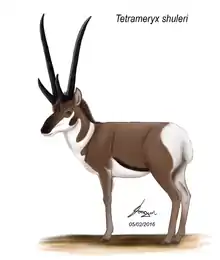Tetrameryx
Tetrameryx is an extinct genus of the North American artiodactyl family Antilocapridae, known from Mexico,[2] the western United States, and Saskatchewan.[1] The name means "four [horned] ruminant", referring to the division of each horn near its base into two prongs; in T. shuleri, the rear prong is much longer.[3]
| Tetrameryx | |
|---|---|
 | |
| Depiction of T. shuleri based on modern pronghorns | |
| Scientific classification | |
| Kingdom: | Animalia |
| Phylum: | Chordata |
| Class: | Mammalia |
| Order: | Artiodactyla |
| Family: | Antilocapridae |
| Genus: | †Tetrameryx Lull, 1921 |
| Species | |
| |
One member of the genus, T. shuleri, survived until about 12,000 years ago, and was present when Paleo-Indians reached North America.[4]
References
- "Tetrameryx Lull 1921". Paleobiology Database. Retrieved 2015-11-21.
- Dalquest, W. W. (1974-03-30). "A New Species of Four-Horned Antilocaprid from Mexico". Journal of Mammalogy. 55 (1): 96–101. doi:10.2307/1379259.
- "Stockoceros and Tetrameryx: the Four-Horned Pronghorns". Prehistoric Pronghorn. International Wildlife Museum. Retrieved 2015-11-21.
- "Tetrameryx shuleri Lull 1921". Paleobiology Database. Retrieved 2015-11-21.
This article is issued from Wikipedia. The text is licensed under Creative Commons - Attribution - Sharealike. Additional terms may apply for the media files.
